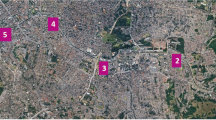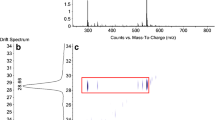Abstract
Liquid chromatography (LC) coupled to hybrid quadrupole time-of-flight (QTOF) mass spectrometry (MS) is a useful analytical tool in the elucidation and confirmation of transformation products (TPs)/metabolites of pesticides with a wide range of polarity, in both environmental and biological samples. Firstly, the versatility of LC allows the determination of very distinct TPs/metabolites as chromatographic conditions can be easily changed and optimized depending on the analytical problem. Secondly, the mass accuracy provided by the TOF analyser allows the assignment of a highly probable empirical formula for each compound and the differentiation between nominal isobaric compounds. Finally, the possibility of performing MS/MS spectra with accurate mass measurements can been used for the final characterization of the TPs/metabolites detected and for the differentiation of isomeric compounds. In this study, the insecticide diazinon was used as model compound, and its photodegradation and metabolism have been investigated by LC-QTOF-MS. On one hand, environmental spiked water was irradiated with a mercury lamp for 9 days, sampling 3-mL aliquots approximately every 12 h. On the other hand, both in vitro and in vivo metabolism experiments were carried out with different substrate concentrations and incubation times. After centrifugation, and protein precipitation in the in vitro and in vivo studies, 50-μL aliquots of both environmental and biological samples were directly injected into the LC electrospray ionization QTOF system. The most important transformation processes were found to be hydrolysis of the ester moiety, hydroxylation in the aromatic ring or in one of the alkylic groups, oxidation of the sulfur atom on the P=S cleavage or a combination of these processes, with the highest number of compounds being found in the photodegradation study. Very polar compounds, such as diethyl phosphate and diethyl thiophosphate, were detected after direct injection of the aqueous sample, which was feasible owing to the characteristics of the LC. In MS mode, mass errors were below 3 mDa, leading to an empirical formula for each compound. MS/MS spectra with accurate mass were used for the final elucidation of the compounds detected.




Similar content being viewed by others
References
Roberts T (1998) (ed) Metabolic pathways of agrochemicals (parts one and two). Royal Society of Chemistry, Cambridge,
Hogenboom AC, Niessen WMA, Brinkman UAT (2000) Rapid Commun Mass Spectrom 14:1914–1924
Kouloumbos VN, Tsipi DF, Hiskia AE, Nikolic D, van Breemen RB (2003) J Am Soc Mass Spectrom 14:803–817
Ibañez M, Sancho JV, Pozo OJ, Hernández F (2004) Anal Chem 76:1328–1335
Bandala ER, Gelover S, Leal MT, Arancibia-Bulnes C, Jiménez A, Estrada CA (2002) Catal Today 76:189–199
Sakkas VA, Labropoulou DA, Sakellarides TM, Albanis TA (2002) Anal Chim Acta 467:233–243
Konstantinou K, Sakkas VA, Albanis TA (2001) Appl Catal B-Environ 34:227–239
Nagahori N, Yoshino H, Tomighara Y, Isobe N, Kaneko H, Nakatsuka I (2000) J Agric Food Chem 48:5754–5759
Levsen K, Schiebel HM, Behnke B, Dotzer R, Dreher W, Elend M, Thiele H (2005) JChromatogr A 1067:55–72
Hongwei Z, Henion J, Yang Y, Spooner N (2000) Anal Chem 72:3342–3348
Hopfgartner G, Chernushevich IV, Covey T, Plomley JB, Bonner R (1999) J Am Soc Mass Spectrom 10:1305–1314
Corcoran O, Nicholson JK, Lenz EM, Abou-Shakra F, Castro-Perez J, Sage AB, Wilson ID (2000) Rapid Commun Mass Spectrom 14:2377–2384
Zhang N, Fountain ST (2000) Anal Chem 72:800–806
Thurman EM, Ferrer I, Parry R (2002) J Chromatogr A 957:3–9
Malato S, Albanis T, Piedra L, Agüera A, Hernando D, Fernandez-Alba A (2003) In: Ferrer I, Thurman M (eds) Liquid chromatography/mass spectrometry, MS/MS and time of flight MS: analysis of emerging contaminants. ACS symposium series 850. American Chemical Society, Washington, DC, pp 66–95
Sakkas VA, Dimou A, Pitarakis K, Mantis G, Albanis T (2005) Environ Chem Lett. DOI 10.1007/s10311–004–0091–6
Bavcon M, Trebse P, Zupancic-Kralj (2003) Chemosphere 50:595–601
Trebse P, Arcon I (2003) Radiat Phys Chem 67:527–530
Poet TS, Wu H, Kousba AA, Timchalk (2003) Toxicol Sci 72:193–200
Abu-Qare A, Abou-Donia MB (2001) Fresenius J Anal Chem 370:403–407
Sams C, Cocker J, Lennard MS (2004) Toxicol Lett Teil Suppl S s146
Hernández F, Sancho JV; Pozo OJ (2002) Rapid Commun Mass Spectrom 16:1766–1773
Hernández F, Sancho JV, Pozo OJ, Villaplana C, Ibáñez M, Grimalt S (2003) J AOAC Int 86:832–838
Acknowledgements
The authors are very grateful to Serveis Centrals d’Instrumentació Científica (SCIC) for use of the Q-TOF hybrid QTOF mass spectrometer and to Marta Miquel and Carlos Aragonés from the Physicobiology Department, University Jaume I, for their excellent technical assistance in the in vivo studies. This work forms part of the research project “Aplicación del acoplamiento cromatografía líquida-espectrometría de masas (LC-MS/MS y LC-QTOF MS) a la identificación de metabolitos de plaguicidas en muestras de interés ambiental y toxicológico” (Ref: BQU2003–02685) developed with financial support of the Ministerio de Ciencia y Tecnología, Spain. M.I. is very grateful to Generalitat Valenciana for her predoctoral grant.
Author information
Authors and Affiliations
Corresponding author
Rights and permissions
About this article
Cite this article
Ibáñez, M., Sancho, J.V., Pozo, Ó.J. et al. Use of liquid chromatography quadrupole time-of-flight mass spectrometry in the elucidation of transformation products and metabolites of pesticides. Diazinon as a case study. Anal Bioanal Chem 384, 448–457 (2006). https://doi.org/10.1007/s00216-005-0167-6
Received:
Revised:
Accepted:
Published:
Issue Date:
DOI: https://doi.org/10.1007/s00216-005-0167-6




